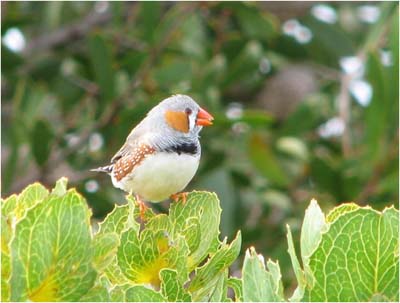Baby birds also babble before singing
The young birds also babble before they can mimic the song of adult birds like our children in our world. Currently, MIT scientists, in the process of studying the way birds and humans learn new behaviors, realize that mature and immature songbirds have two nerve pathways. difference, not a path of gradual growth. Their research was published in the May 2 issue of Science.
Michale Fee, the lead author of the study and neuroscientist at the Institute of Brain Research McGovern at MIT and associate professor of MIT's Department of Cognitive and Brain Sciences, said: 'Bird babbling Young in the process of learning illustrates the behavior of exploration that exists in every species that we often consider to be a game but in fact it is an essential 'trial and error' way of learning. "
In the first stage, young manholes have a young, changeable song. They practice continuously without stopping until a typical mature song never changes. Fee explained that: 'Initial diversity is essential in the learning process. So we want to find out if it's caused by an immature motor pathway or another path. '
Previous studies have shown that manholes have two distinct brain pathways that make songs , one for learning and the other - also called the motion path - to create a mature song. If the first path is destroyed when the young bird is in the process of learning will prevent this process from progressing, so the song is still immature and incomplete. But for adult birds that have mastered the singing, if the road is destroyed, their song will not be affected.

Fragile birds.(Photo: gallery.hampel.com.au)
Researchers believe that the motor nerve pathway is equally important in creating babbling of young birds, but interestingly, no one has ever done an experiment to find out the true problem. The first author, Dmitriy Aronov and co-author Aaron Andalman, are both graduate students in Fee's laboratory, using Fee's lab-developed techniques to temporarily stop working. some parts of the brain as well as information from neurons of songbirds.
The results are very surprising.
When they paralyze a part of the HVC-named motorway in young birds, they continue to sing . That means there is another area of the brain that commands the song of the young bird. The authors argue that the key component in this pathway has the name LMAN with a previously unknown motor function. They determined this by proving that when LMAN was paralyzed in young birds, they stopped chirping.
Aronov explained: 'This shows us that singing is controlled by two different motor lines at different stages of development. We have long known that these two pathways function in different stages of development, so there must be a functional equivalent that we discover with the known things about anatomy. '.
But what happened to LMAN during adulthood after the birds learned the song? Contrary to the notion of 'use or loss', the authors found that LMAN maintains the ability to babble songs even when they grow up. Preventing the HVC pathway in adult birds makes them immediately return to the singing stage. This shows that the LMAN line can restart the process if the stronger signal from the HVC line is inhibited.
Fee said that these results could be widely used in undeveloped forms or other human and bird exploration behaviors. He said: 'For birds, the exploration phase ends when the learning process is completed. But we humans can always ask that the equivalent of LMAN is the active, creative frontal lobe to learn new things. '
- Bird language helps patients recover quickly
- How do birds learn to sing?
- Secretly put the lyrics on the wings
- Why are female birds singing less and less?
- Ca trù - Intangible cultural heritage
- Fake rubber device singing birds
- Pollution makes birds sing better
- Ask easy, difficult to answer: Why do birds sing?
- Birds transmit success messages in songs
- Singing helps you be young and healthy
- The sooner the eggs are laid, the better the birds sing
- Birds singing also has grammar!
 Animal 'suffering' after hibernation
Animal 'suffering' after hibernation Why do goats climb well?
Why do goats climb well? Scientists were surprised to see chimpanzees eating turtles
Scientists were surprised to see chimpanzees eating turtles Giant catfish died deadly due to drought in Thailand
Giant catfish died deadly due to drought in Thailand Why can migratory birds fly thousands of kilometers without eating?
Why can migratory birds fly thousands of kilometers without eating?  When it rains, where do the birds take shelter?
When it rains, where do the birds take shelter?  100 years ago, a man released 60 strange birds, causing the US to lose $1 billion a year.
100 years ago, a man released 60 strange birds, causing the US to lose $1 billion a year.  Ancient Egyptian masterpiece so realistic that scientists accurately identified the birds in the painting
Ancient Egyptian masterpiece so realistic that scientists accurately identified the birds in the painting  Scientists plan to turn dead birds into drones
Scientists plan to turn dead birds into drones  Why did birds survive while dinosaurs became extinct?
Why did birds survive while dinosaurs became extinct? 